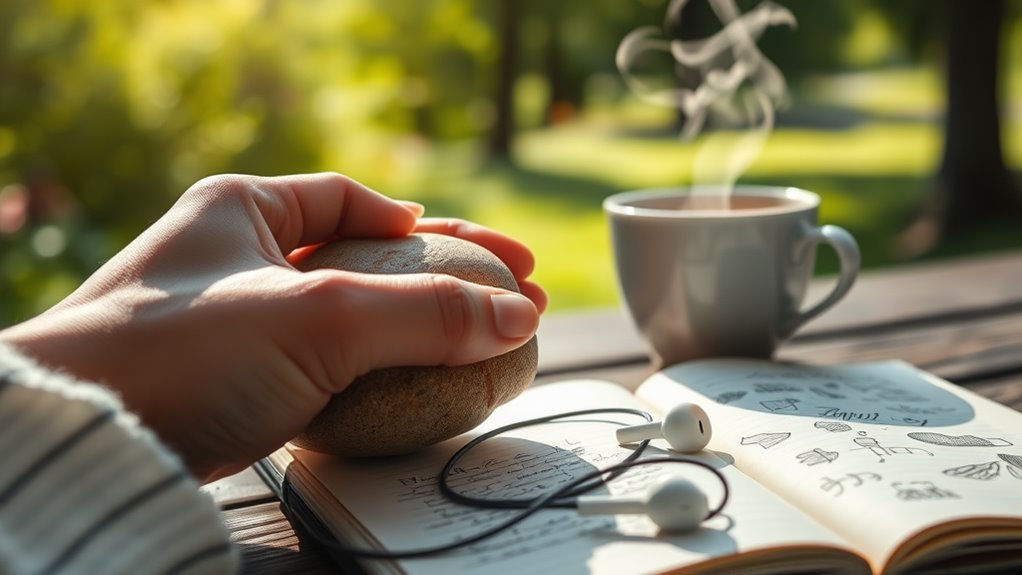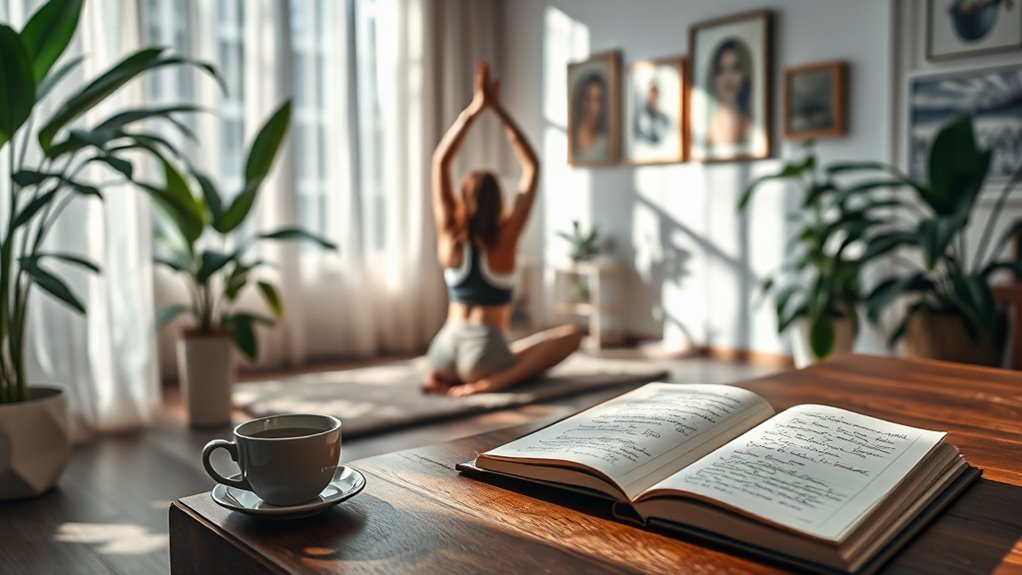Stress Relief Tips That Don’t Require Fancy Tools
You can easily relieve stress without fancy tools by using simple techniques. Start with mindful breathing: inhale deeply through your nose and exhale slowly through your mouth. Progressive muscle relaxation works well too; tense and relax each muscle group, focusing on the sensations. Consider taking a nature walk—immersing yourself in the outdoors helps clear your mind. Journaling can help you process emotions and track stress triggers. Finally, try visualization exercises, picturing calming scenes or achieving your goals. These methods are effective and accessible. Stick around, and you’ll discover even more ways to manage stress in your daily life.
Key Takeaways
- Practice mindful breathing by focusing on deep inhalations and slow exhalations to promote relaxation and reduce stress.
- Use progressive muscle relaxation to identify and release tension in your body, starting from your toes up to your face.
- Take nature walks to immerse yourself in calming surroundings, enhancing mindfulness and boosting your mood through physical activity.
- Engage in journaling to process emotions, reflect on daily experiences, and create gratitude lists for a more positive outlook.
- Utilize visualization exercises to create a mental sanctuary by picturing serene scenes and achieving personal goals, promoting relaxation and joy.
Mindful Breathing Techniques
Mindful breathing techniques are a powerful way to reduce stress and regain focus. When you practice these techniques, you center your attention and calm your mind.
Start by finding a quiet space. Close your eyes and take a deep breath in through your nose, filling your lungs completely. Hold that breath for a moment, then slowly exhale through your mouth.
Repeat this process, focusing solely on your breath. If your mind wanders, gently bring it back to the sensation of inhaling and exhaling. You can try counting your breaths to maintain your focus.
Just a few minutes of mindful breathing can help you feel more grounded and clear-headed. Incorporate this practice into your daily routine for lasting benefits.
Progressive Muscle Relaxation
After practicing mindful breathing, you might want to explore another effective method for relieving stress: Progressive Muscle Relaxation (PMR).
This technique helps you identify and release tension in your body. To start, find a quiet space and sit or lie down comfortably.
Begin with your toes, tensing the muscles for five seconds, then release and notice the difference. Gradually work your way up through your legs, abdomen, arms, and face, tensing each muscle group before relaxing.
Focus on the sensations of tension and relaxation. PMR not only helps calm your mind but also promotes body awareness.
Nature Walks for Calm
While you may find yourself overwhelmed by daily stressors, taking a nature walk can provide a revitalizing escape. Stepping outside and immersing yourself in the sights and sounds of nature instantly calms your mind.
The gentle rustle of leaves, the chirping of birds, and the fresh air work together to create a soothing atmosphere. As you walk, focus on your surroundings; notice the colors, textures, and scents around you. This mindfulness can help ground you, pulling your attention away from stressors.
Plus, the physical activity boosts endorphins, further enhancing your mood. Whether it’s a nearby park or a scenic trail, nature walks offer a simple yet powerful way to alleviate stress and promote inner peace.
Journaling for Stress Relief
Taking a break in nature can clear your mind, but another effective way to manage stress is through journaling. Writing down your thoughts helps you process emotions and gain clarity. You don’t need fancy materials; just grab any notebook and pen.
Here’s a simple table to guide your journaling:
| What To Write | Benefits |
|---|---|
| Daily Reflections | Increases self-awareness |
| Gratitude Lists | Boosts positivity |
| Stress Triggers | Identifies patterns |
Set aside a few minutes each day to jot down your feelings or experiences. You’ll find it’s a powerful tool for stress relief, helping you to release tension and gain perspective.
Visualization Exercises
When you visualize calming scenes or positive outcomes, you engage your mind in a powerful way to reduce stress. This technique allows you to escape from the chaos of daily life and tap into a more peaceful mindset.
Here are some effective visualization exercises you can try:
- Picture a serene beach with gentle waves lapping the shore.
- Imagine yourself achieving a personal goal, feeling the joy of success.
- Visualize a peaceful forest where you can breathe in fresh, clean air.
- Envision a warm, comforting light surrounding you, providing safety and relaxation.
Practicing these exercises regularly can help you create a mental sanctuary, making it easier to handle stress whenever it arises.
Give it a try, and notice the difference it makes!
Simple Stretching Routines
After engaging in visualization exercises to calm your mind, it’s important to incorporate physical relaxation techniques as well.
Simple stretching routines can effectively relieve stress and tension in your body. Start with neck rolls to release tightness; gently roll your head in circles.
Next, try shoulder shrugs—lift your shoulders toward your ears and then relax them down. Move on to a forward bend, reaching for your toes while keeping your knees slightly bent. This releases pressure in your lower back.
Finally, end with a seated twist, which enhances flexibility and aids digestion. Take deep breaths during each stretch, allowing your body to relax further.
These routines can be done anywhere, so take a few moments whenever you need a break.
Frequently Asked Questions
How Long Should I Practice These Stress Relief Techniques Daily?
You should practice these stress relief techniques for about 10 to 20 minutes daily. Consistency is key, so find a routine that fits your schedule, and you’ll likely see benefits over time.
Can I Combine Multiple Techniques for Better Results?
Absolutely, you can combine multiple techniques for better results! Mixing methods often enhances effectiveness, allowing you to tailor your approach to what feels best for you. Experiment and find the combination that brings you the most relief.
What if I Struggle to Focus During Breathing Exercises?
If you struggle to focus during breathing exercises, try counting your breaths or using visualization. You can also start with shorter sessions, gradually increasing the time as you become more comfortable and focused.
Are These Techniques Suitable for Children or Teens?
Absolutely, these techniques are suitable for children and teens. They can help improve focus and emotional regulation. Just guarantee you adapt the methods to their age and understanding for the best results.
How Quickly Can I Expect to See Results From These Methods?
You might notice results from these methods within a few days to weeks. Consistency is key, so stick with them, and you’ll likely experience reduced stress levels and improved overall well-being over time.





